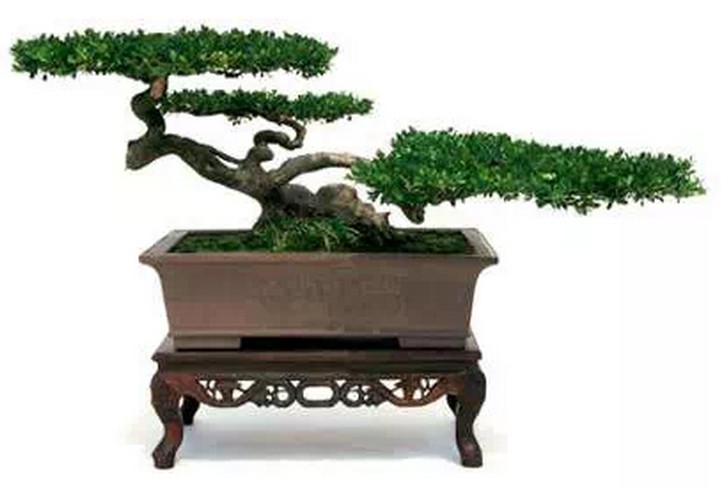The forming History of Yang School Bonsai Art
Yang School bonsai art was formed in the Ming Dynasty and matured in the Qing Dynasty. It draws on natural materials, imitates nature, absorbs traditional Chinese humanistic values and aesthetic ideas, integrates poetry, calligraphy, painting and techniques, and inherits the context of Chinese bonsai art with the style of elegance, elegance, elegance and freehand brushwork and the cutting techniques of "fine cutting" and "one inch and three bends". It ranks side by side with Su School, Sichuan School, Lingnan School and Shanghai School.

Zhang Zhihan, a native of the Yuan Dynasty, mentioned in the poem "Xie Tan Xuezheng sent potted plum" that it took only a moment for several plum plants in Yangzhou last year to be red and white. There is a basin of more than six feet in it. " This is the earliest record of Yangzhou bonsai trees. The artistic style of Yangpai bonsai was formed in the Ming Dynasty. From the existing ancient cypress bonsai at the end of Ming Dynasty, we can see the technology at that time.
There is a sentence in Li Dou's "Yangzhou painting Boat record", "every family has a garden, and every household keeps bonsai." Yangzhou in Qianlong's heyday, ah, drooled all over the place. Shen Fu, who was also born in the heyday of Emperor Qianlong, wrote in the second volume of six stories of floating Life: "there are tourists from Yushan who sent Huang Yang Cui Bai each in Yangzhou merchants," and the bonsai became an elegant ceremony.
There are two important factors in the rapid development of Yangzhou bonsai in Qing Dynasty. One is the participation of the literati. They not only love bonsai, but also make it themselves, and make a lot of poems and paintings for bonsai. Second, the intervention of the leisure class represented by Yangzhou salt merchants, who employed full-time bonsai craftsmen for a long time and made bonsai carefully, which objectively promoted the improvement of Yangzhou bonsai skills.
Bonsai on the visual focus of the inner door of Wuthering Heights in Yangzhou
A case study of Indoor Bonsai and display in Yangzhou Garden
The characteristic of Yangzhou bonsai is to see the whole through a small part, draw lessons from the painting theory, and learn from nature. Today, there is a pair of couplets at the gate of Yangpai Bonsai Museum: "with less than more, Yao Cao Qi Hua Rong four seasons; that is, small view big, abbot Penglai see a spot." Although Lianlian thinks it is cobbled together, it also tells the true meaning of Yangpai bonsai. With a square inch of land to concentrate heaven and earth, mountains, trees, flowers and stones, reflecting poetic and picturesque, based on nature and higher than nature, this is the essence of Yangpai bonsai.
Time: 2019-06-04 Click:
- Prev

The creative skills of Yangpai bonsai
Yang sent bonsai according to the Chinese painting branch without inch straight painting principle, using brown silk banding, requiring fine binding and fine cutting. Each branch in the cloud is tied into a very fine serpentine bend, the densest one can have three bends per inch, and the leaves are flat and tilted, parallel and standing, called one inch and three bends.
- Next

Antique Yangpai bonsai in Ming and Qing dynasties
Family-style bonsai workshops appeared in Yangzhou in the Qing Dynasty. In the 1950s and 1960s, Yangzhou Garden Department collected bonsai from the folk, and successively collected 24 bonsai pots in Ming and Qing dynasties. These living cultural relics have become an important collection of today's Yangpai Bonsai Museum. 1. Relics of juniper at the end of Ming Dynasty and Tianning Temple in Yangzhou
Related
- Fuxing push coffee new agricultural production and marketing class: lack of small-scale processing plants
- Jujube rice field leisure farm deep ploughing Yilan for five years to create a space for organic food and play
- Nongyu Farm-A trial of organic papaya for brave women with advanced technology
- Four points for attention in the prevention and control of diseases and insect pests of edible fungi
- How to add nutrient solution to Edible Fungi
- Is there any good way to control edible fungus mites?
- Open Inoculation Technology of Edible Fungi
- Is there any clever way to use fertilizer for edible fungus in winter?
- What agents are used to kill the pathogens of edible fungi in the mushroom shed?
- Rapid drying of Edible Fungi

